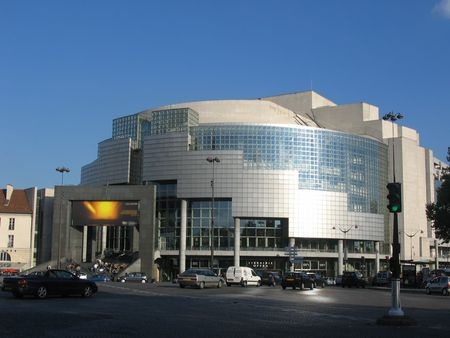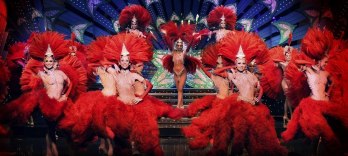Daughter of the Regiment
Mo | Tu | We | Th | Fr | Sa | Su |
First part
Act 1
The year is 1815, in the Tyrolean mountains. The Marquise de Berkenfield and her butler Hortensius have been caught by surprise by the advancing French troops the very day they are preparing to flee to Austria. The Marquise finds herself among the villagers. The men are carrying rifles, the women are praying to the Virgin Mary (Sainte Madone).
Perhaps as a result of the prayers, the French troops leave the mountain. The Marquise is relieved, after having been so afraid (Pour une femme de mon nom). She retires to get some rest. Left alone, Hortensius finds himself opposite Sulpice, a sergeant in the 21st regiment. The butler is terribly afraid but he manages to obtain a pass for himself and his mistress. Marie joins Sulpice. She is the adopted daughter of the regiment that found her on a battlefield twelve years earlier (Au bruit de la guerre, j’ai reçu le jour).
The entire regiment has acted as a father to her (Mon régiment, j’en suis fière vraiment). Lately, Marie has become a vivandière (Nommée à l’unanimité). However, for some time now, Marie has been seeing a Tyrolean partisan, Tonio. Sulpice is anything but happy with his daughter’s new relationship. Marie is sad and in love. She and Tonio have decided not see each other anymore. Meanwhile, the entire regiment arrives escorting the Tyrolean who, at the risk of being killed, has come to meet with Marie. (C’est un traître, qu’il périsse). Marie saves Tonio just as he saved her life after she almost fell off a cliff while picking flowers (Quoi, la mort à celui qui me sauva la vie!). The Tyrolean drinks to his new friends, Marie sings the regimental song (Il est là, morbleu, le beau Vingt-et-unième).
The regiment leaves taking Tonio with them, but he soon escapes to return to Marie (Quoi ! Vous m’aimez ?). Sulpice surprises them. Marie is compelled to admit to Tonio that she can only marry a soldier from the 21st regiment. Tonio refuses to give up. The Marquise of Berkenfield is given an escort by Sulpice in order to return to her castle. But Sulpice recognizes the name Berkenfield: the same name was on the letter found next to the infant Marie when she was recovered on the battlefield. We learn that the Marquise is the aunt of the vivandière. Appalled by Marie’s manners, she decides to bring her niece to the castle in the hope of giving her a decent education. Unfortunately Tonio has just enlisted on the French side (Ah! Mes amis, quel jour de fête!). He wins the hand of the vivandière. But Marie must leave the man she loves and her regiment (Il faut partir).
Second part
Act 2
We are at the home of the Marquise de Berkenfield. The latter has just arranged an advantageous marriage for Marie with Duke Scipion de Crackentorp. Sulpice, who is also at the castle is supposed to be assisting the Marquise in her project to re-educate Marie. On the agenda: music. Today, Marie has to sing an Italian love song (Le jour naissait dans le bocage). But Sulpice encourages Marie into disobedience (Rataplan, c’est le refrain du régiment). The military song blends with the love song.
The Marquise is furious and Marie is very unhappy (Sous les bijoux et la dentelle, je cache un chagrin sans espoir). Just then, the entire regiment bursts into the castle (C’est elle, notre fille!). Tonio is among them. The soldiers seize Hortensius, the butler. Tonio and Sulpice stay with Marie (Tous les trois réunis). Tonio asks the Marquise for Marie’s hand (Pour me rapprocher de Marie). The Marquise refuses so Tonio makes up his mind to speak. He has learned from his uncle that the Marquise is not Marie’s aunt. He considers abduction. However, alone with Sulpice, the Marquise admits the truth.
She is in fact Marie’s mother and the father was Captain Robert, a soldier. Afraid that a love affair unbefitting of her station would become public, she abandoned her child. The guests arrive for the signature of the marriage contract. Marie refuses to leave her room. The Marquise doesn’t know what to do. The dreadful Duchess of Crackentorp quickly grows impatient. Meanwhile, Sulpice decides to enlighten Marie as to the secret of her birth.
She can no longer refuse. Marie indeed comes out of her room. However, as she prepares to sign the contract, all the soldiers, led by Tonio, burst into the marriage chamber (Au secours de notre fille, nous accourrons tous ici). The guests are horrified to learn that the young girl was a vivandière (Une fille de régiment) but confronted by Marie’s feelings, they change their opinion (Au fait, elle est charmante). The Marquise does not wish to sacrifice her daughter and accepts her marriage to Tonio. Everyone present sings a final: Salut à la France.
CHARACTERS
Marie: young vivandière
Tonio: young Tyrolean
Sulpice: sergeant
The Marchioness of Berkenfield
Hortensius: marquise's steward
The Duchess of Crakentorp
Program and cast
Comic opera in two acts (1840)
Opéra-comique en deux actes
Creative team
Gaetano Donizetti - Music
Jules-Henri Vernoy de Saint-Georges - Libretto
Jean-François Bayard - Libretto
Evelino Pidò - Conductor
Ching-Lien Wu - Chorus master
Laurent Pelly - Director and costume design
Chantal Thomas - Set design
Joël Adam - Lighting design
Laura Scozzi - Choreography
Agathe Mélinand - Dramaturgy
Cast
Julie Fuchs - Marie
Lawrence Brownlee - Tonio
Lionel Lhote - Sulpice
Susan Graham - The Marchioness of Berkenfield
Florent Mbia - Hortensius
Felicity Lott - The Duchess of Crakentorp
Cyrille Lovighi - A peasant
Mikhail Silantev - The Corporal
The Paris Opera Orchestra and Chorus
A production Metropolitan Opera, New York, Royal Opera House Covent Garden, London, Staatsoper, Vienna
Language : French
Surtitle : French / English
Duration :
Opening
First part - 80 minutes
Intermission - 30 minutes
Second part - 50 minutes
End
Paris Opera Bastille

RM Europa Ticket GmbH is an officially accredited ticket reseller of/by Opera National de Paris.
Agency number: 4848428
Opéra Bastille
A great modern theatre
The Opéra Bastille is the work of the Canadian-Uruguayan architect Carlos Ott, who was chosen in November 1983 after an international competition that attracted entries from some 1,700 architects. The theatre was inaugurated on July 13th 1989.
Its architecture is marked by transparent façades and by the use of identical materials for both the interiors and the exteriors.
With its 2,700 acoustically consistent seats, its unique stage facilities, its integrated scenery, costume and accessory workshops, as well as its numerous work areas and rehearsal rooms, the Opera Bastille is a great modern theatre.
Stage facilities
Orchestra pit, mobile and adjustable, can be covered; at its largest it can house 130 musicians
Main stage, 45 m high, 30 m wide, 25 m deep, made up of 9 elevators allowing several levels to be created and supported by three main elevators, which bring scenery up from below stage
Clearing zones, 4 storage areas with the same dimensions as the stage
Backstage area, with its scenery turntable
Circulation area, scenery temporarily stored between the stage, workshops and rehearsal stage
Rehearsal stage, the Salle Gounod, with its orchestra pit and dimensions identical to those of the main stage
The building
Area at ground level: 22,000 m²
Floor area: 160,000 m²
Total height: 80 m (including 30 m below street level)
The auditoriums
The main auditorium
Area: 1,200 m², 5% of the total for the building
Dimensions: 20 m high, 32 m deep, 40 m wide
Number of seats: 2,703
Materials: blue granite from Lannelin in Brittany, pearwood from China, glass ceiling
The amphitheatre
Area: 700 m²
Depth : 21.4 m
Number of seats : 450
Materials: white breccia marble from Verona, staff ceiling
The Studio
Area: 280 m²
Depth: 19,5 m
Number of seats: 237
Materials: white breccia marble from Verona and pearwood
Performances: Mo 20 May 2024,
Performances: Su 19 May 2024,
Performances: Su 26 May 2024,
Performances: Th 23 May 2024,
Performances: Su 19 May 2024,
Performances: Mo 20 May 2024,

 EN
EN DE
DE IT
IT FR
FR ES
ES RU
RU JP
JP RO
RO
 Seating plan
Seating plan 




